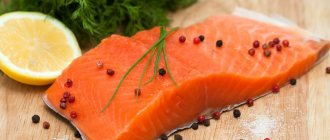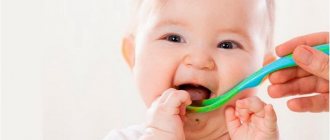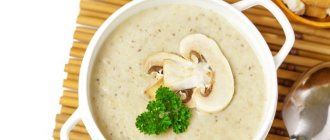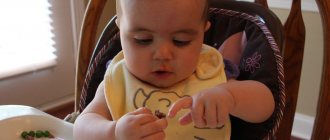Fish must be included in baby's complementary foods. Without this product, the baby’s body will not receive enough substances necessary for proper development. In the diet of children under one year old, fish appears one of the last, as it belongs to the category of intense allergens. Not every type of product is suitable for complementary feeding. In order not to harm the baby, parents need to know exactly what fish to introduce into the first feeding and how.
At what age should fish be introduced into complementary foods?
Severely allergenic foods should be introduced into a child’s diet only when his body is already strong enough. For babies who are on formula, the product can be included in the diet from 8 months. If the baby is fed breast milk, then fish should appear in the diet only from 9 months.
Before new complementary foods are introduced into the diet, the baby must get used to meat, vegetables and fruits. If they are not absorbed well enough, then you need to wait before introducing a new product. It will also be necessary to delay the start of feeding fish until 11-12 months if the child suffers from severe allergies. In such a situation, you cannot put additional stress on the body.
About the benefits
The nutritional value of fish is not inferior to meat, and due to the smaller amount of connective tissue, it is more easily absorbed by the body.
This product will provide children with B vitamins necessary for proper metabolism. Children will also receive vitamin A, which is responsible for good vision, and vitamin D, which is involved in the formation and strengthening of skeletal muscles.
Fish contains a rich list of substances useful for children: phosphorus, magnesium, calcium, potassium, sodium, iron, fluorine, as well as iodine, the amount of which is important for stimulating mental abilities and neuromuscular development.
Why is this product necessary?
Fish is a unique product that is completely absorbed by the body. Due to the absence of coarse fibers and fats, which are refractory, the child’s not yet fully developed digestive system can efficiently absorb this component of the diet.
Fish meat is rich in minerals and fatty acids, which are necessary for proper brain development. It is impossible to fully replace these substances artificially. Proteins in the product actively participate in the formation of muscle tissue and allow the baby to fully develop physically.
Beneficial features
If you regularly consume pollock, you can get the following benefits:
- blood sugar levels decrease;
- the functioning of the thyroid gland is normalized;
- the condition of the nervous and digestive systems improves;
- teeth and bone tissue are strengthened;
- the condition of bones, nails and skin improves;
- blood cholesterol levels decrease;
- blood pressure and metabolism return to normal.
If you consume 100 g of this healthy product, you can fill the body’s daily need for iodine, chromium and cobalt. Iodine is necessary for the effective functioning of the thyroid gland, which ensures the normal functioning of all organs and the well-being of the person himself. Cobalt produces a hemostatic effect and regulates carbohydrate metabolism.
It also promotes normal absorption of iron, which can prevent the development of anemia. Chromium is a necessary element to ensure normal carbohydrate and lipid metabolism in the human body.
The calorie content of this fish is low (70 kcal per 100 g), which allows you to include it in your diet without worrying about your figure.
Delicious Pollock in the oven with a crispy crust
Ready-made canned fish puree
The main enterprises producing complementary foods for infants also produce canned fish formulas. They have certain advantages, and pediatricians often recommend paying attention to them. It is especially important to introduce fish using ready-made formulations if the child has poor tolerance to new foods in the diet and experiences intestinal problems.
The positive properties of ready-made complementary foods with fish are as follows:
- complete safety of the product for children and the presence of all necessary certificates for each component of canned food;
- the presence of vegetables or cereals in the composition, which increases the calorie content of the product and makes it easier for the baby to get used to fish;
- a taste that almost every child likes;
- an opportunity to save time for parents, since ready-made canned food only needs to be heated.
If you decide to introduce fish into your baby’s complementary foods using ready-made purees, you need to choose products from well-known companies, preferably those whose products are already in the baby’s diet. If you have any difficulties choosing a product, your pediatrician will help you decide on the best one.
Canned fish for children
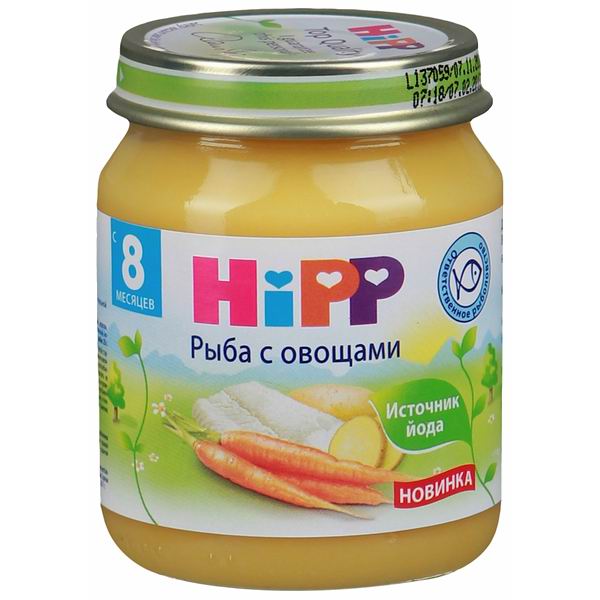
Canned food for children may contain either sea or river fish.
The most common vegetable ingredient in fish and vegetable dishes is:
- cauliflower;
- root vegetables: potatoes and carrots;
- broccoli;
- zucchini;
- pumpkin.
Thanks to vegetables, the biological value of the final product significantly increases , since they enrich the dish with dietary fiber, which is almost completely absent from fish.
To prepare canned fish and cereals, porridges such as pearl barley, rice, buckwheat, corn and semolina are used.
Also, canned fish may contain a little vegetable oil or sometimes butter. The preservative is usually ascorbic acid.
Tokareva Larisa, pediatrician
9, total, today
( 170 votes, average: 4.52 out of 5)
Eye teeth are being cut: symptoms, how to help your child
Breastfeeding problems: how to improve lactation?
Related Posts
Which fish to choose for complementary feeding
The fish that will be the first in the child’s diet must be chosen correctly. Not all varieties are allowed to be included in baby food. If necessary, you can check with your pediatrician which fish to choose. This must be done if the baby has any intestinal pathologies.
The best first fish for feeding a baby:
- cod,
- hake,
- zander,
- sea bass,
- pink salmon.
Speaking about what kind of fish to start feeding a child with, we cannot help but note the general requirements for the product. Ignoring them leads to a serious deterioration in the baby’s condition and difficulties in introducing fish. The product must meet the following requirements:
- minimal fat content;
- low allergenicity rate;
- freshness – it is advisable to choose the product chilled. However, this is not available for residents of regions far from the sea. In such places, sea fish, which is sold chilled in stores, is defrosted. Frozen fish is safer as it reduces the risk of becoming infected with any parasites.
When buying a frozen product for your baby, you need to carefully study the packaging and look at the dates of catching and freezing. You should not feed your baby a product that has been stored for more than 5 months. Ideally, fish for a child’s first feeding, if it is frozen, should be caught no more than 3 months before the date of purchase.
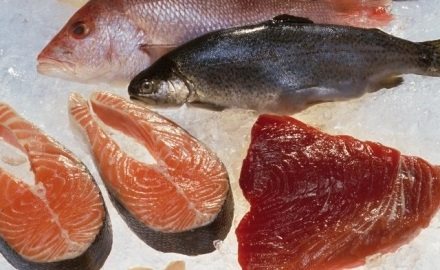
Choosing fish for baby food
What kind of fish can you cook and offer to your baby? The baby's pancreas is not able to cope with fatty foods, so complementary feeding for a child under 12 months of age begins with low-fat varieties.
| Group of fish | Kinds | Product fat content | Child's age |
| Lean (skinny) | Cod, pike perch, hake, pollock, river perch, flounder, navaga | Up to 4% | From 9-11 months |
| Medium fat | Sea bass, sea crucian carp, trout, pink salmon, herring, sturgeon, chum salmon | 4-8% | From 1.5-2 years |
| Fat | Salmon, mackerel, herring, eel, omul | Above 8% | From 3-4 years |
What fish should you not give to your child? There are species that feed on carrion. It is better to avoid such a product to avoid infecting the body with parasites. Even the fact that fish will be cooked for children does not eliminate the danger. Most often, river species are infected with parasites, so it is better to give preference to sea varieties. In addition, in terms of phosphorus and iodine content, seafood is ahead of its river counterparts.
What quality of product should you avoid? Fish grown in private reservoirs can be dangerous for children. To speed up growth, the fry are fed special hormones. Consuming such a product is harmful.
It is better to use fresh or chilled fish, which retain as much nutrients as possible.
How to determine how long a product has been on the store counter and what is its freshness? The following signs indicate good quality:
- The scales fit tightly to the fish and shine.
- The eyes are bulging, without cloudiness.
- The gills are quite hard, bright red or pink.
- When you press on the abdomen, the dent quickly disappears. Abdominal bloating is a sign of spoilage!
How long can the product be stored after purchase? You can keep fresh fish in the cold for up to 2 days, and if you freeze it, then up to 3-6 months.
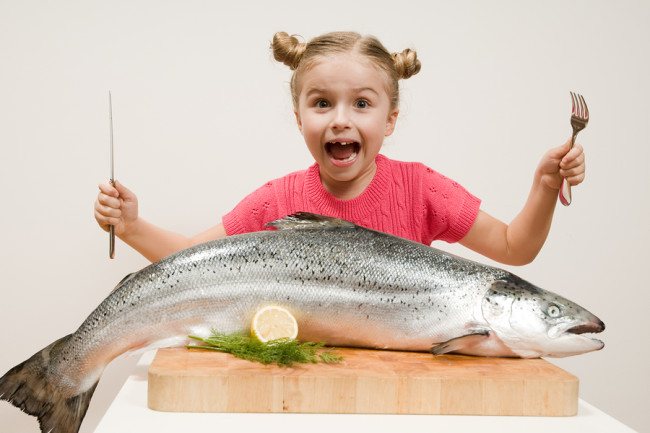
What to do when there is no fresh product on sale? What kind of fish, in this case, is permissible to give to a child under one year old? You can purchase frozen fish fillets or whole fish in stores.
When purchasing, you should ask about the date of capture and freezing. It is important to consider how much time has passed since the day of freezing: the fresher the product, the more microelements it contains. A smooth, transparent crust of ice indicates that the product has not been defrosted.
To preserve the maximum amount of microelements, fish should be thawed in lightly salted water. After defrosting, you can conduct another suitability test: pay attention to the condition of the product. When the pulp falls apart, does not hold its shape and resembles a rag, this means that the product is damaged. You shouldn't cook this fish for kids. Any suspicion of poor quality cannot be ignored, because the health of children is more important than the money spent.
How to give fish
It is important to know not only when to introduce fish into your child’s complementary foods, but also how. Due to the increased allergenicity of the product, it is initially given in a minimal amount and the baby’s condition is carefully monitored.
For the first time, fish in the form of puree is given to the baby in the amount of ¼ teaspoon. After this, the baby’s well-being is monitored for the next 3 days. The product is not provided during this period. If there are no signs of intolerance, then the volume of puree is increased to ½ teaspoon. So, increasing the volume every 3 days, the baby’s portion is increased to 50 g per feeding within 30 days. By 12 months, you need to further increase the volume of fish and bring it to 70 g. After a year of the product, you need 90 g.
Fish should be given 2 times a week. If the baby tolerates complementary feeding well, you can diversify the menu with new varieties of product. Fatty types will seriously overload the not yet fully formed digestive system and can cause diarrhea. Such nutrition is allowed only after 2-3 years, depending on the individual characteristics of the baby’s body.
Signs of allergies
Not all babies tolerate the product well, and they may develop an allergy to it. The symptoms of this condition are quite varied, but there are also manifestations of intolerance common to most infants. The following phenomena indicate that complementary feeding should not be given and that seeking medical help is required:
- swelling of the face - usually starts from the lips and then spreads to the entire face, and in severe cases to the neck and larynx. In a particularly dangerous condition, Quincke's edema may occur;
- intense redness of the skin and the appearance of rashes;
- severe itching;
- nausea and vomiting;
- intense abdominal pain;
- diarrhea.
If allergy symptoms appear, the child should be given an antihistamine previously recommended by the pediatrician and seek medical help.
After the allergic attack is completely relieved, if the doctor gives permission, you should try giving complementary foods again, but using ready-made canned food or a different type of fish. In some cases, your pediatrician may recommend delaying introduction of the product until 12 months of age or even older. Such instructions should not be violated.
When should fish products not be introduced?
Fish can cause negative reactions in children. To prevent this from happening, you need to choose the right moment to introduce it into the diet.
You should not give the product in the following cases:
- vaccination was carried out less than 10 days ago;
- the baby has suffered or is suffering viral infections;
- the child suffers from seasonal allergies;
- there will be a stressful situation associated with the trip;
- the moment of introducing another new complementary food.
At a time when fish is introduced into children’s diets, it is important that there is no other burden on the body. This significantly reduces the risk of allergies and deterioration of the baby’s condition.
Cooking features
Parents are interested in how to prepare fish for the first feeding so that it is as healthy as possible and the baby likes it. There are several ways to prepare the product. The simplest is steaming.
The cleaned piece of fish is brought to readiness in a double boiler, and then sorted with your hands for the presence of bones. Even the smallest ones must be removed. Next, the fish mass is crushed using a blender to a puree. The resulting dish can be served in its pure form. If desired, to increase nutritional value and a more familiar taste for the baby, it is useful to mix fish puree with carrot, potato or zucchini in a 1/1 ratio.
Steam cutlets are given to children aged 11 months. They are prepared without adding salt and spices. If your baby cannot yet switch to such a dish with vegetable puree, do not rush him. Some children master fish in a different form only by the age of 2. Some babies categorically refuse to eat complementary foods, and it is impossible to persuade them to do so. In such a situation, a consultation with a pediatrician is required to select the most complete menu for the harmonious development of the baby.
When and what kind of fish to introduce into complementary foods for children under one year old largely depends on the individual characteristics of the child, as well as living conditions. If it is impossible to buy a quality product, then complementary feeding has to be postponed until one and a half to two years. When it is possible to obtain fresh river fish of high quality, it is worth trying to replace frozen sea fish with it, since the first product will be healthier.
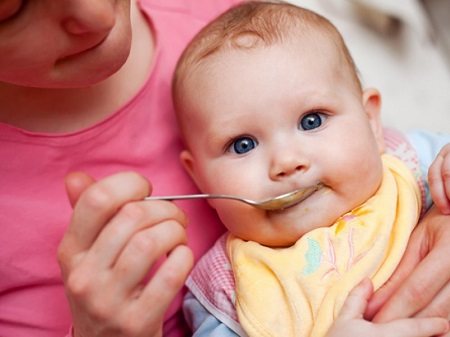
Cooking fish dishes at home
Fish puree
Fish fillet (without skin) - 60 g, milk and vegetable oil - 1 tsp. spoon.
Boil the fillet in a small amount of water for 15-20 minutes, cool, mince or beat in a blender, after removing all the bones. Add milk, butter, salt, mix well and bring to a boil over low heat.
Steam fish soufflé
Fish fillet - 100 g, milk - 25 g, flour - 3 g, egg - 1/3 pcs., butter - 5 g.
Boil the fish fillet, remove all bones. Pass through a meat grinder with a fine grid, add thick milk sauce (boil the milk with flour for 5-8 minutes), butter, egg yolk, mix, carefully fold the whipped white into the minced meat. Place the mixture in a greased form and cook in a water bath under the lid for 15-20 minutes.
Fish pudding
Fish fillet - 100 g, potatoes - 1/2 pcs., butter - 2 teaspoons, milk - 2 tbsp. spoons, egg - 1/4 pcs.
Boil the peeled potatoes until fully cooked, drain the water, mash with a wooden pestle so that there are no lumps, and dilute with milk. Boil the fish in salted water, remove all the bones. Finely chop the pulp, mix with potatoes, lightly salt, add melted butter (1 teaspoon), yolk and white whipped into a thick foam. Grease the mold with oil, pour the mixture into it, close the lid, place in a water bath and cook for 20-30 minutes.
Fish meatballs
Fish fillet - 60 g, wheat bread - 10 g, yolk - 1/4 pcs., water - 10 ml, vegetable oil - 4 ml.
Remove the bones from fish fillets (for example, cod), pass through a meat grinder with a piece of bread soaked in water, add egg yolk and vegetable oil, mix thoroughly. Form balls from the resulting mass, place in a bowl half filled with water and cook over low heat for 20-30 minutes.
Steamed fish cutlets
Fish fillet - 80 g, milk - 25 ml, white bread - 10 g, egg - 1/4 pc.
Pass the fish fillet through a meat grinder, add white bread soaked in milk, mix, pass through the meat grinder again, add salt, beat the egg and mix until a homogeneous fluffy mass is obtained. Form cutlets from the mixture, steam them, placing them on the grate of a steam pan (special grate inserts for cooking steamed dishes in regular pans can be purchased in the hardware departments of department stores), for 20-30 minutes.
